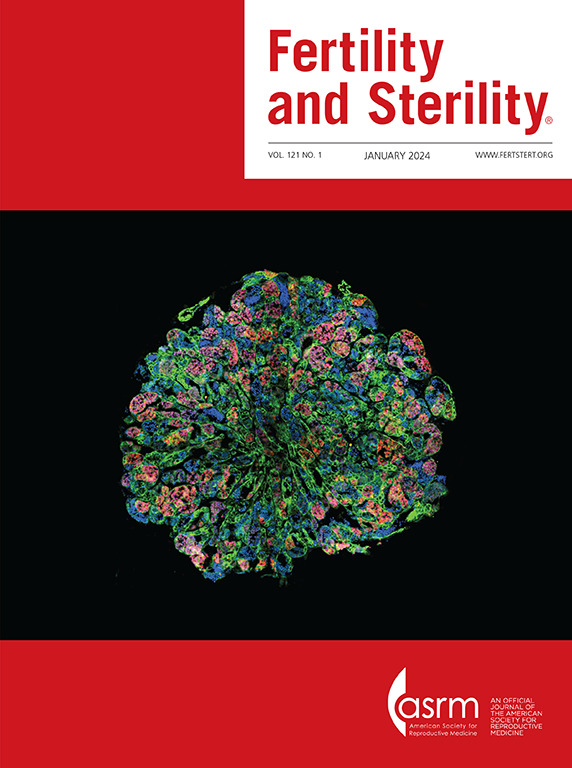Polycystic ovary syndrome and elevated body mass index independently increase type 2 diabetes risk with obesity-mediated risk dominating: a real-world data analysis of US patients.
IF 7
1区 医学
Q1 OBSTETRICS & GYNECOLOGY
引用次数: 0
Abstract
OBJECTIVE To study the relationship between polycystic ovary syndrome (PCOS) and type 2 diabetes mellitus (T2DM) in a retrospective US cohort. DESIGN Longitudinal case-control study. SUBJECTS The study utilized data from the IBM Explorys database, a comprehensive real-world dataset containing de-identified, longitudinal patient-level electronic health records (EHRs) from approximately 400 hospitals across the United States (US). The study population consisted of women diagnosed with PCOS between 2000 and 2020, aged 25 to 55 years (n = 42,030) and control women without PCOS (n = 84,060), matched 1:2 by ethnicity, geographic region, age, and BMI. Additionally, a secondary control group (n = 42,030) was employed, matched on all covariates except BMI. EXPOSURE PCOS status was identified using ICD-coded diagnoses, while T2DM diagnosis was determined using ICD-coded diagnoses as well as Hemoglobin A1c (HbA1c) levels. MAIN OUTCOME MEASURES The incidence of T2DM. RESULTS The 3-year cumulative incidence rates of T2DM in the PCOS and non-PCOS cohorts were 9.2% (95% Confidence Interval: 8.9% - 9.5%) and 6.0% (5.8% - 6.2%), respectively. The 15-year cumulative incidence rates were 34.3% (31.4% - 37.4%) and 22.6% (21.2% - 24.1%), respectively. The adjusted hazard ratio (HR) of T2DM in women with PCOS was 1.47 (1.41 - 1.53) compared to control individuals. HRs for PCOS were found to be consistent in different BMI strata ranging from 1.37 in the obese class III subgroup to 1.78 in the subgroup with normal weight. The median BMI in the PCOS cohort was 34.86 kg/m2, in contrast to 27.26 kg/m2 in non-PCOS controls not matched for BMI. The additional HR for T2DM associated with this BMI difference of 7.6 kg/m2 is estimated to be 1.87 (1.82 - 1.92). CONCLUSIONS In the current analysis, PCOS was independently associated with increased T2DM incidence across all BMI categories. Moreover, the elevated BMI in PCOS patients confers additional T2DM risk mediated by excess adiposity. This BMI-mediated risk exceeds the risk associated with PCOS through other mechanisms, such as hyperandrogenism.多囊卵巢综合征和体重指数升高分别增加2型糖尿病的风险,其中肥胖介导的风险占主导地位:对美国患者的真实世界数据分析。
目的通过美国回顾性队列研究多囊卵巢综合征(PCOS)与2型糖尿病(T2DM)的关系。设计纵向病例对照研究。本研究利用了IBM Explorys数据库中的数据,该数据库是一个全面的真实世界数据集,包含来自美国约400家医院的去识别的纵向患者级电子健康记录(EHRs)。研究人群包括2000年至2020年间诊断为多囊卵巢综合征的女性,年龄在25岁至55岁之间(n = 42030)和对照组无多囊卵巢综合征的女性(n = 84060),按种族、地理区域、年龄和BMI匹配1:2。此外,采用第二对照组(n = 42,030),除BMI外,所有协变量均匹配。使用icd编码诊断来确定exsurepcos状态,而使用icd编码诊断和血红蛋白A1c (HbA1c)水平来确定T2DM诊断。主要观察指标:T2DM的发生率。结果PCOS组和非PCOS组3年累计T2DM发病率分别为9.2%(95%可信区间:8.9% ~ 9.5%)和6.0%(5.8% ~ 6.2%)。15年累计发病率分别为34.3%(31.4% ~ 37.4%)和22.6%(21.2% ~ 24.1%)。与对照组相比,PCOS女性T2DM的校正危险比(HR)为1.47(1.41 - 1.53)。多囊卵巢综合征的HRs在不同BMI层中是一致的,从肥胖III类亚组的1.37到正常体重亚组的1.78。多囊卵巢综合征队列的中位BMI为34.86 kg/m2,而BMI不匹配的非多囊卵巢综合征对照组的中位BMI为27.26 kg/m2。与7.6 kg/m2的BMI差异相关的T2DM的额外HR估计为1.87(1.82 - 1.92)。结论:在目前的分析中,多囊卵巢综合征与所有BMI类别中T2DM发病率的增加独立相关。此外,多囊卵巢综合征患者BMI升高会增加肥胖介导的额外T2DM风险。这种bmi介导的风险超过了通过其他机制(如高雄激素症)与多囊卵巢综合征相关的风险。
本文章由计算机程序翻译,如有差异,请以英文原文为准。
求助全文
约1分钟内获得全文
求助全文
来源期刊

Fertility and sterility
医学-妇产科学
CiteScore
11.30
自引率
6.00%
发文量
1446
审稿时长
31 days
期刊介绍:
Fertility and Sterility® is an international journal for obstetricians, gynecologists, reproductive endocrinologists, urologists, basic scientists and others who treat and investigate problems of infertility and human reproductive disorders. The journal publishes juried original scientific articles in clinical and laboratory research relevant to reproductive endocrinology, urology, andrology, physiology, immunology, genetics, contraception, and menopause. Fertility and Sterility® encourages and supports meaningful basic and clinical research, and facilitates and promotes excellence in professional education, in the field of reproductive medicine.
 求助内容:
求助内容: 应助结果提醒方式:
应助结果提醒方式:


